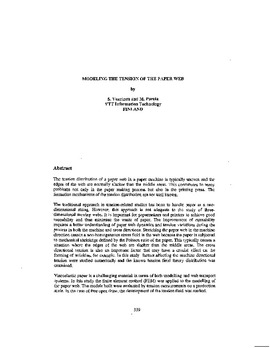| dc.contributor.author | Vuorinen, S. | |
| dc.contributor.author | Parola, M. | |
| dc.contributor.other | International Conference on Web Handling (2001) | |
| dc.date.accessioned | 2019-11-08T18:59:15Z | |
| dc.date.available | 2019-11-08T18:59:15Z | |
| dc.date.issued | 2001-06 | |
| dc.identifier | oksd_icwh_2001_vuorinen | |
| dc.identifier.citation | Vuorinen, S., & Parola, M. (2001, June). Modeling the tension of the paper web. Paper presented at the Sixth International Conference on Web Handling (IWEB), Stillwater, OK. | |
| dc.identifier.uri | https://hdl.handle.net/11244/321834 | |
| dc.description.abstract | The tension distribution of a paper web in a paper machine is typically uneven and the edges of the web are normally slacker than the middle areas. This contributes to many problems not only in the paper making process but also in the printing press. The formation mechanisms of the tension distribution are not well known. | |
| dc.description.abstract | The traditional approach in tension-related studies has been to handle paper as a one-dimensional string. However, this approach is not adequate to the study of three-dimensional moving webs. It is important for papermakers and printers to achieve good runnability and thus minimize the waste of paper. The improvement of runnability requires a better understanding of paper web dynamics and tension variations during the process in both the machine and cross directions. Stretching the paper web in the machine direction causes a non-homogeneous stress field in the web because the paper is subjected to mechanical shrinkage defined by the Poisson ratio of the paper. This typically causes a situation where the edges of the web are slacker than the middle areas. The cross directional tension is also an important factor that may have a crucial effect on the forming of wrinkles, for example. In this study factors affecting the machine directional tension were studied numerically and the known tension field theory distribution was examined. | |
| dc.description.abstract | Viscoelastic paper is a challenging material in terms of both modelling and web transport systems. In this study the finite element method (FEM) was applied to the modelling of the paper web. The models built were evaluated by tension measurements on a production scale. In the case of free open draw, the development of the tension field was studied. | |
| dc.description.abstract | The influence of mechanical conditions, such as guiding rolls, was modeled in press room conditions. Steady state analysis was performed for a moving paper web. The modelling results gave a better understanding of web transportation and FEM appears to be a promising tool for analyzing paper web behavior in different web handling systems. | |
| dc.format | application/pdf | |
| dc.language | en_US | |
| dc.publisher | Oklahoma State University | |
| dc.rights | In the Oklahoma State University Library's institutional repository this paper is made available through the open access principles and the terms of agreement/consent between the author(s) and the publisher. The permission policy on the use, reproduction or distribution of the article falls under fair use for educational, scholarship, and research purposes. Contact Digital Resources and Discovery Services at lib-dls@okstate.edu or 405-744-9161 for further information. | |
| dc.title | Modeling the tension of the paper web | |
| osu.filename | oksd_icwh_2001_vuorinen.pdf | |
| dc.type.genre | Conference proceedings | |
| dc.type.material | Text | |
